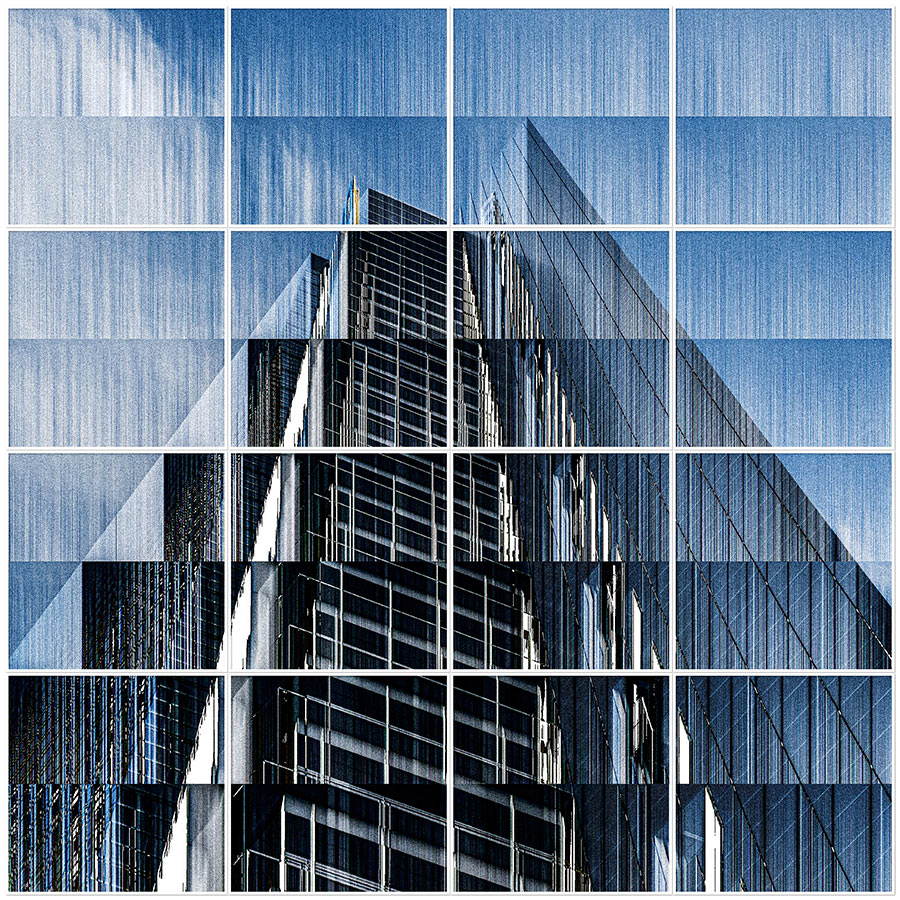
2022-0002 _ 16M2 /
/ 16 teilig – 16-part /
/ je – each 64x64cm – 25,2×25,2inch /
/ edition of 2
>> mehr werke: move – stadtlandschaften I // more works: move – urban landscapes I
Marc Peschke: Enigmatische Splitter
zur Serie „move“ von falk.brvt
Im Jahr 2021 entschloss sich falk.brvt (Falk Baron Rausch von Traubenberg), seine seit Jahren auf vielen Bühnen in Deutschland entstehenden Theaterfotografien in eine freie, künstlerische Serie zu überführen. Dies geht mit einer Abstrahierung weg vom konkreten Bühnenstück einher, wie der Künstler selbst sagt: „in move abstrahiere ich das motiv aus dem konkreten bühnenstück und reduziere es auf seinen theatralen kern von licht, raum und bewegung.“
Aus der Bearbeitung der Theaterbilder entwickelte sich etwas später eine Erweiterung der Werkgruppe „move“, in der falk.brvt all jene Werke in einer offenen Gruppe zusammenfasst, die ihrem Wesen nach mit „Bewegung“ zu tun haben – von Kamera-, Scanner- bis hin zu Datenbewegungen. Es entstanden Bilder, die nun als strukturelle Neuinterpretationen des real Gesehenen zu verstehen sind – eine Dekonstruktion bis hin zu einer völligen Zerstörung des Realen. Es sind Architektur- oder Landschaftsbilder, die ebenfalls aufgrund von „Bildbewegungen“ entstehen. Auch hier gliedert, wie stets im Werk von falk.brvt, die Zahl Acht als Grundklang die Einzelbilder oder Tableaus aus 4, 16 oder 64 Bildern, die jeweils 64 x 64 cm groß sind. Jedes Motiv dieser Arbeiten gibt es also in vier Größen.
Um diese abstrahierenden Bilder vielleicht besser zu verstehen, sie in einen fotogeschichtlichen Kontext einzuordnen, sei ein Blick in die Historie der Fotografie empfohlen: Die abstrakte Fotografie hat inzwischen eine lange Geschichte. Die Fotogramme von Christian Schad oder László Moholy-Nagy – Zeichnungen des Lichts auf dem Fotopapier, Fotografien, die ohne Kamera entstanden sind – gehören zu den wichtigen frühen Beispielen abstrakter Fotokunst. Vor allem der Bauhauslehrer László Moholy-Nagy formulierte seine Vision einer abstrakten Fotografie schon im frühen 20. Jahrhundert: „malen ohne pigment nur mit reinem licht im grenzbereich zwischen malerei und fotografie“.
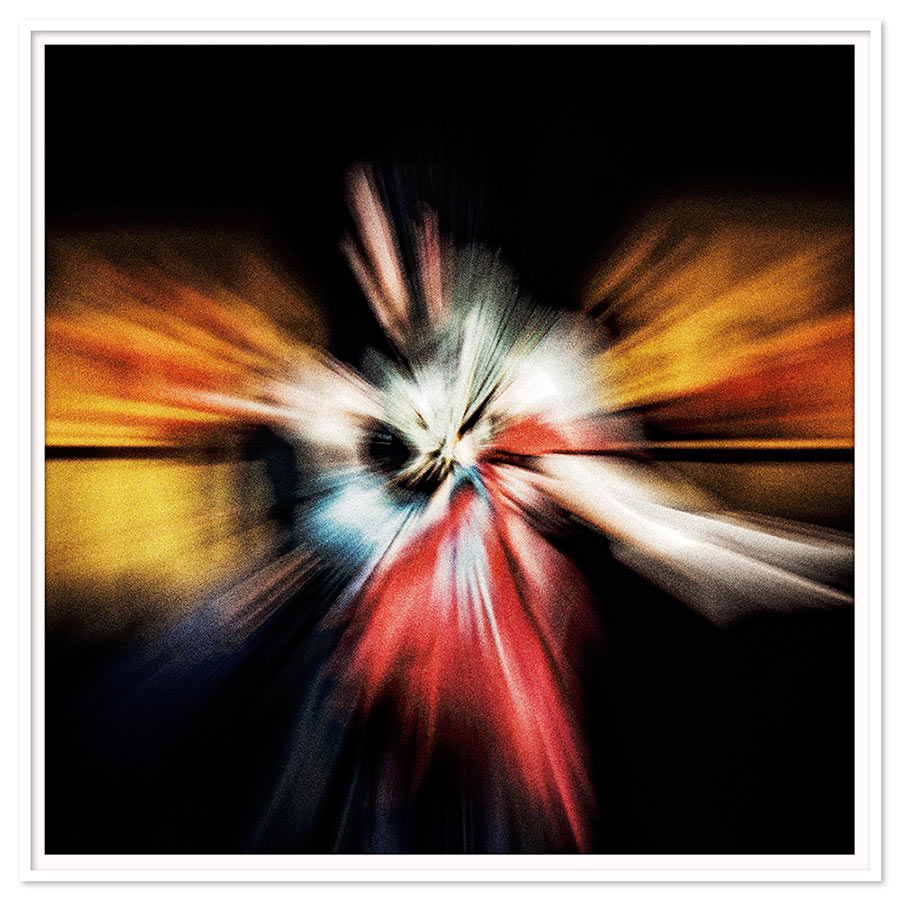
2021-0001 _ 01M1 /
/ 1 teilig – 1-part /
/ 64x64cm – 25,2×25,2inch /
/ edition of 8
>> mehr werke: move – bühnenraum I // more works: move – stage space I
Etwa hundert Jahre nach dem Beginn der abstrakten Fotografie scheint dieser Strang der Fotokunst heute so lebendig wie eh und je. Immer neue Künstlergenerationen hinterfragen das Bild der Wirklichkeit, in dem sie es mehr und mehr auch mit digitalen Mitteln abstrahieren und reduzieren. Die Abstraktion vom Gegenstand scheint auch im 21. Jahrhundert noch eine adäquate Methode zu sein, der Welt zu begegnen – um ihr eigentliches Wesen, womöglich ihr Streben nach Transzendenz zu erkennen.
Die Nähe zum Architekturbild liegt auch in der Biografie des Künstlers begründet, der sich als Künstler seit 2018 „falk.brvt“ nennt. Er ist ausgebildeter Architekt, hat seit 1994 an der Fachhochschule Konstanz Architektur studiert. In seinen Werken spielen die Geometrie, die Mathematik, Zahlenreihen eine wichtige Rolle. Sein ganzes Leben als Künstler hat er mit der Zahl 8 gegliedert: Acht mal acht Jahre will er künstlerisch tätig sein – bis zu seinem 86sten Lebensjahr im Jahr 2057. Die Gliederung dieses Künstlerlebens in Phasen („Der Anfang“ 1994 bis 2001, „the orange years“ 2002 bis 2017…, „falk.brvt“ seit 2018) ist ein weiterer interessanter Aspekt in diesem Werk.
Doch kehren wir zurück zu den neuen Arbeiten der offenen Werkgruppe „move“ (es existieren außerdem die Gruppen „core“ und „note“), die für den Künstler den „oberbegriff jeglicher bewegung“ darstellen. Er unterteilt die Serie in „M1“ (die Interpretation der Theaterbilder) und „M2“ (die fragmentierten Architektur- und Berglandschaftsbilder, die unter anderem im Montafon im Südwesten Österreichs entstanden sind). Die Zersplitterung des Realen gründet in verschiedenen Manipulationen des Bildes. Es sind Fehler der Kamera oder des Scanners, Übertragungsfehler, die falk.brvt absichtlich initiiert – mit denen er arbeitet. Aus Fehlern entstehen maschineneigene Bilder in der digitalen Dunkelkammer, denen ein magisches Potential innezuwohnen scheint.
Susan Sontag, William Henry Fox Talbot, vor allem aber Walter Benjamin haben den, wie es Benjamin formuliert, „magischen Wert“ der Fotografie in ihren Schriften hervorgehoben. Benjamin hat in seinem 1931 veröffentlichten Aufsatz „Kleine Geschichte der Photographie“ auf den „magischen Wert“ der Fotografie hingewiesen. Damit meinte er auch in besonderer Weise die Absichtslosigkeit, wenn er schreibt: „Es ist ja eine andere Natur, welche zur Kamera als welche zum Auge spricht; anders vor allem so, daß an die Stelle eines vom Menschen mit Bewußtsein durchwirkten Raums ein unbewußt durchwirkter tritt.“
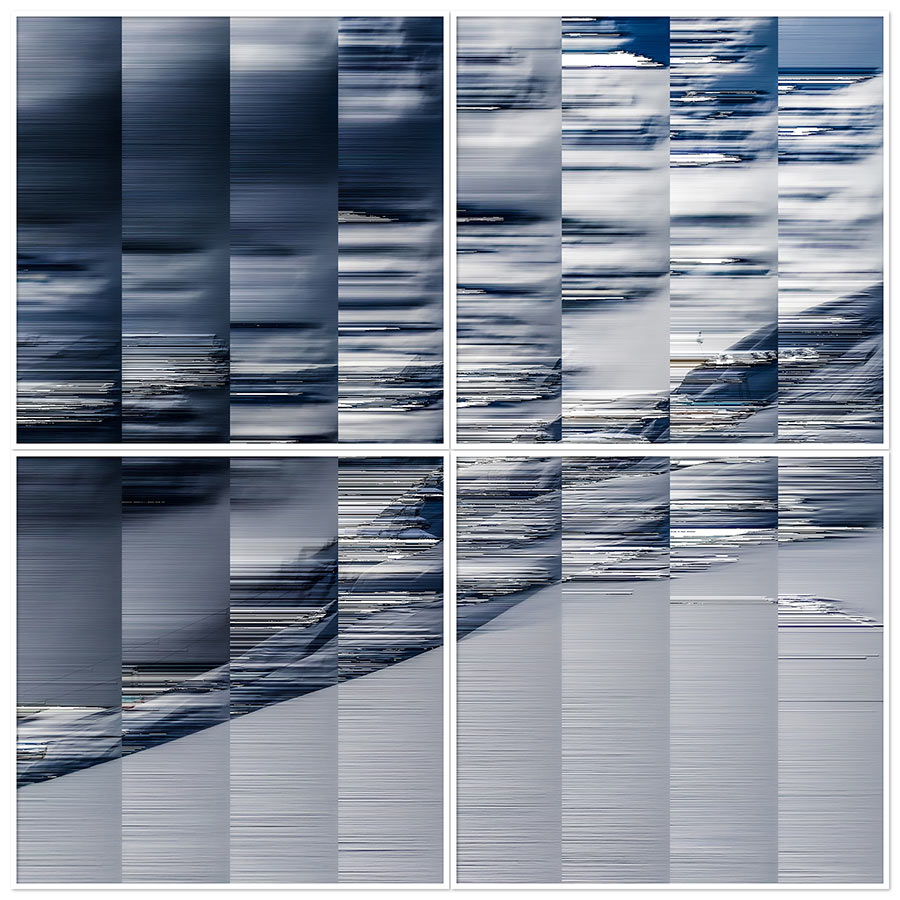
2023-0001 _ 04M2 /
/ 4 teilig – 4-part /
/ je – each 64x64cm – 25,2×25,2inch /
/ edition of 4
>> mehr werke: move – berglandschaften I // more works: move – mountain landscapes I
Die Absichtslosigkeit des Zufalls, des digitalen Fehlers, verbindet falk.brvt mit Stilwillen und Erfahrung zu kühlen, abstrakten Formulierungen, in denen etwas Unsagbares steckt. Diese Bilder zwischen Zerstörung und Klarheit: Sie kommen aus einer ganz eigenen, ungemein weiten Welt, nämlich aus dem Inneren des technischen Apparates. Diese Fotografien erzählen von einer grenzenlosen Freiheit, die in der dunklen Kammer der Kamera zu herrschen scheint. Ist der Fehler in Gang gesetzt, gibt es kein Zurück mehr. Der Künstler greift nicht nachträglich in das fehlerhafte Bild ein.
Das Enigmatische in diesen Bildern bestätigt ein weiteres Mal, dass der Abbildungscharakter des Fotografischen schon lange obsolet ist. Stattdesseen sucht der Künstler nach neuen Bildern, die er auf dem Feld des Architekturbildes oder auch der Landschaftsfotografie, des Bergbildes findet: Stets sind es kristalline Formen, Datensplitter, aus denen sich neue architektonische Landschaften formen: zersplitterte Landschaften, kristallin, voller digitaler Fehler und Leerstellen, geschult am Dekonstruktivismus der Postmoderne. Immer wieder dieses Aufbrechen und Aufsplittern geschlossener Flächen! Sind es Felsen, Glasfronten oder Eisschollen? Stets betont falk.brvt die Künstlichkeit des Gezeigten, die Leerstellen in unserer Wahrnehmung von Landschaft. Die „Leerstelle“ – ein Begriff, den man auch aus der literaturwissenschaftlichen Rezeptionsästhetik kennt – könnte man eine Grundkonstante dieser Serie nennen.
Eine Leerstelle, lehrt uns Wikipedia, „ist in der Kristallographie ein Platz in der regelmäßigen Anordnung von Atomen, Ionen oder Molekülen im Kristallgitter, der unbesetzt ist.“ Diese unbesetzten Plätze, diese digitalen Leerstellen und Fehler, diese Verletzungen der Bilder, das ist der eigentliche Kern dieser Kunst. Und dieser Kern erzählt von der Welt, in der wir leben. Er dient der Wahrnehmung, ist ein Spiegel dieser Zeit, die bereits 1990 von Paul Virilio als „rasender Stillstand“ beschrieben worden ist. Das Ende der Bewegung, sagt der 2018 verstorbene postmoderne Geschwindigkeitstheoretiker, ist erreicht: ein Endstadium. Das Ende der Ära der Beschleunigung, die in Krisen, Kriegen, Katastrophen, in digitalen Fehlern austrudelt und still steht. Die Bilder von falk.brvt kann man auch in diese Richtung denken. Als bewegte, bewegende Bilder eines paradoxalen rasenden Stillstands digitalen Gegenwart.
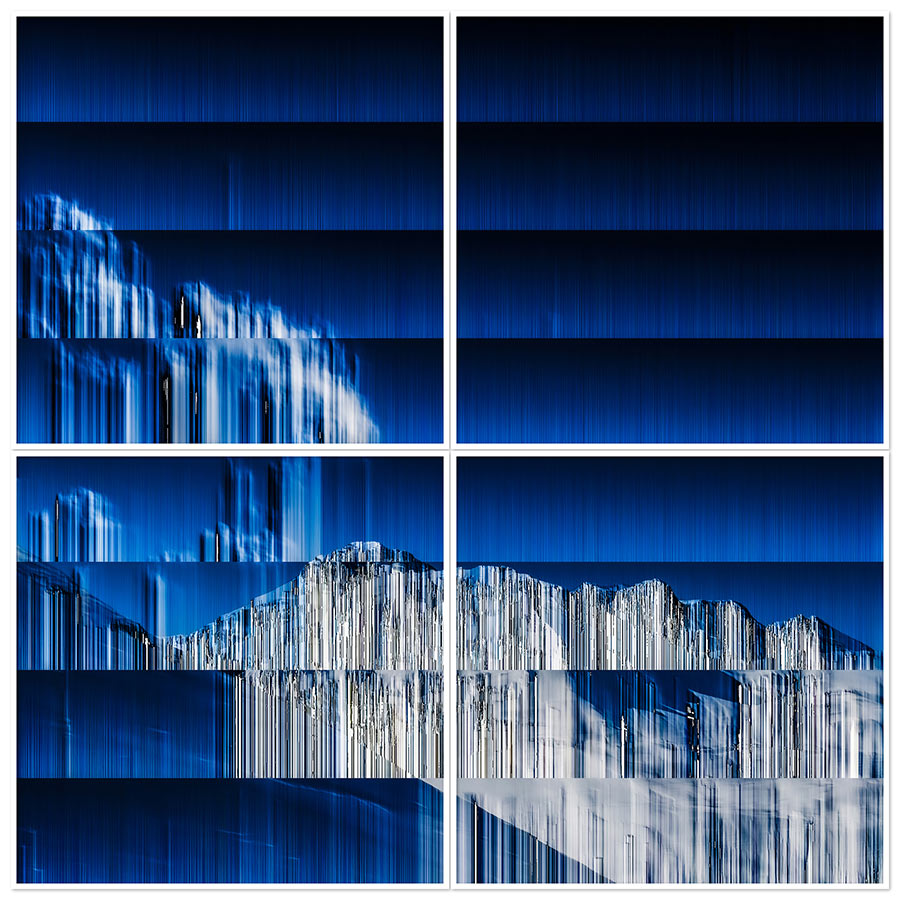
2023-0002 _ 04M2 /
/ 4 teilig – 4-part /
/ je – each 64x64cm – 25,2×25,2inch /
/ edition of 4
>> mehr werke: move – berglandschaften I // more works: move – mountain landscapes I
Marc Peschke: Enigmatic Splinters
On the series “move” by falk.brvt
Translation by Kristina von Bülow
In 2021, falk.brvt (Falk Baron Rausch von Traubenberg) decided to transform his theatre photography that he has been creating for years on numerous stages in Germany into a free, artistic series. Synchronously, the concrete stage play becomes subject to abstraction, as the artist himself says: “in move, i abstract the motif from the concrete stage play and reduce it to its theatric core of light, space, and movement.”
A little while thereafter, an extension of the work group “move” developed through the editing process of the theatre images, in which falk.brvt integrates within an open group all of those works that deal with “movement” – camera movements, scanner movements, data movements. The thereby created images are to be understood as a structural reinterpretation of visual reality – a deconstruction or even a complete destruction of the real. They are architecture and landscape pictures that are created based on “image movements” as well. As usual in the work of falk.brvt, the number eight structures the individual pieces or tableaus of 4, 16, or 64 images that are each 64 x 64 cm in size. Thus, all of the motifs of these works are available in four sizes.
In order to perhaps understand these abstracting images better, to position them in a photo-historical context, a look at the development of photography is recommended: Abstract photography already has a long history. The photograms by Christian Schad or László Moholy-Nagy – drawings of light on photo paper, photographs created without camera – are some important early examples of abstract photographic art. In particular the Bauhaus teacher László Moholy-Nagy already formulated his vision of an abstract photography in the early 20th century: “painting without pigment only with pure light in the intersection of painting and photography”.
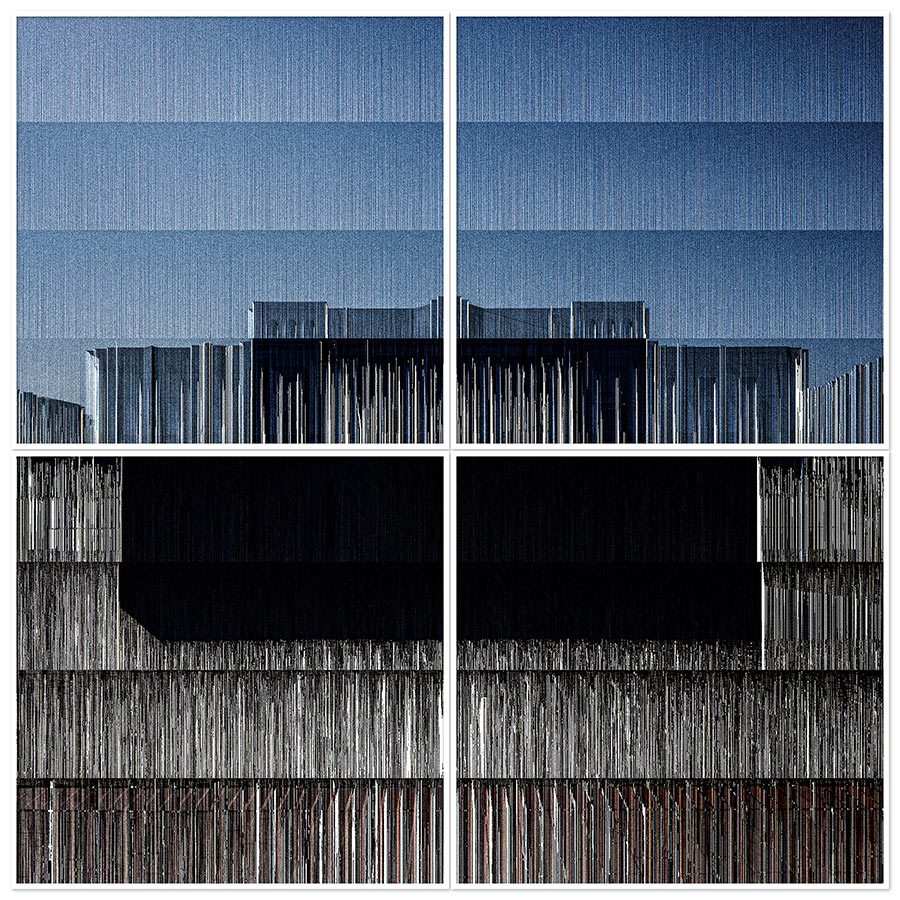
2022-0001 _ 04M2 /
/ 4 teilig – 4-part /
/ je – each 64x64cm – 25,2×25,2inch /
/ edition of 4
>> mehr werke: move – stadtlandschaften I // more works: move – urban landscapes I
About a hundred years after the origin of abstract photography, this thread of photo art today seems to be as alive as ever. New artist generations continue to question the image of reality by abstracting and reducing it ever more with digital means. In the 21st century, abstraction of the object appears to still be an adequate method of facing the world – in order to recognise its actual nature and maybe even its striving for transcendence.
The proximity to architectural imagery is rooted in the biography of the artist who assumed the artist name “falk.brvt” in 2018. He is trained as an architect, studied architecture from 1994 on at Fachhochschule Konstanz. In his work, geometry, mathematics, number sequences play an important role. The artist subdivided his whole life based on the number 8, intending to be active as an artist for 8 x 8 years – until his 86th birthday in 2057. The division of this artist life into phases (“the beginning” 1994 to 2001, “the orange years” 2002 to 2017 …, “falk.brvt” since 2018) is another interesting aspect of this oeuvre.
In returning to the new works of the open group “move” (additionally, there are the groups “core” and “note“), for the artist they represent the “umbrella term for any type of movement”. He subdivides the series into “M1” (the interpretation of the theatre images) and “M2” (the fragmented images of architecture and mountain landscapes that have been created in Montafon in the southwest of Austria, among other places). The fragmenting of the real is based on various manipulations of the image, errors of the camera or of the scanner, transfer errors that falk.brvt initiates on purpose – that he works with. Errors transform to in-machine images in the digital darkroom, seemingly embodying magical potential.
Susan Sontag, William Henry Fox Talbot, and particularly Walter Benjamin have emphasized the “magical value”, as Benjamin puts it, of photography in their writings. In his essay “A Short History of Photography”, published in 1931, he refers to the “magical value” of photography. He distinctly means non-intentionality when he writes: “It is a different nature that speaks to the camera than the one speaking to the eye; different especially insofar as that a space previously pervaded with human consciousness is now filled with the subconscious.”
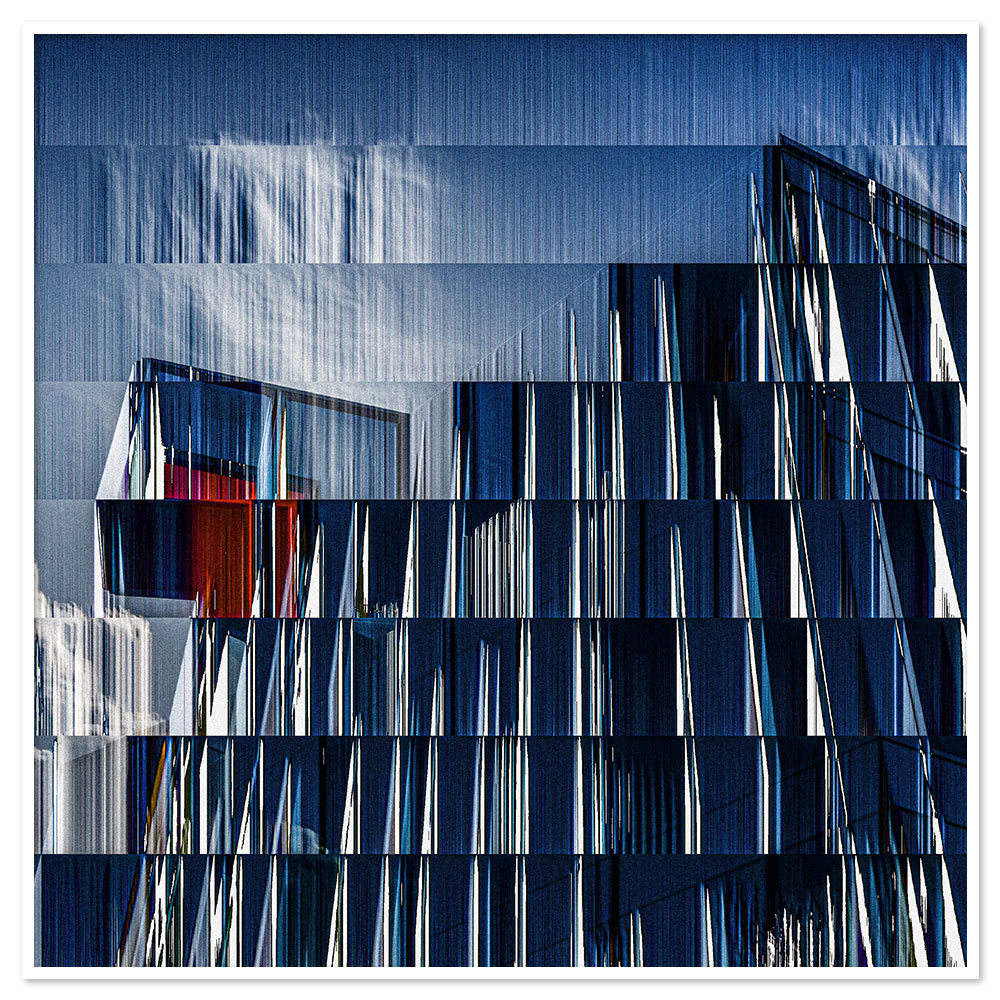
2023-0019 _ 01M2 /
/ 1 teilig – 1-part /
/ 64x64cm – 25,2×25,2inch /
/ edition of 8
falk.brvt connects the non-intentionality of the coincidence, of the digital error, with purposed style and experience to create cool, abstract formulas that contain something unspeakable. These images between destruction and clarity: They come from an entirely own, tremendously wide world, namely from the interior of the technical apparatus. These photographs tell of limitless freedom that seems to exist in the dark chamber of the camera. Once the error has been initiated, there is no return. The artist does not interfere retroactively with the erroneous image.
The enigmatic aspect of these images confirms once more that the representative nature of photography has been obsolete for a long time already. Instead, the artist searches for new images that he finds in the field of architectural imagery or in landscape photography, of the mountain image: New architectural landscapes are throughout shaped by crystalline forms, by data splinters: fragmented landscapes, crystalline, full of digital errors and empty spaces, informed by the deconstructivist side of postmodernism. Time and again this breaking open and fragmenting of closed surfaces! Are they rocks, glass fronts, or ice floes? falk.brvt always emphasizes the artificiality of what is shown, the empty spaces in our perception of landscape. The “empty space” – a term that is also known from the reception aesthetic of literature – could be identified as a basic constant of this series.
An empty space or a vacancy, as Wikipedia tells us, is “in crystallography a type of point defect in a crystal where an atom is missing from one of the lattice sites.” These vacant spots, these digital empty spaces and errors, these injuries of images are the real core of this art. And this core speaks of the world in which we live. It serves perception and it is a mirror of these times that have been described as “rushing standstill” by Paul Virilio as early as 1990. The end of movement, says the postmodern speed theorist deceased in 2018, is reached: a final stage. The end of the era of acceleration, which runs down and stops in crises, wars, catastrophes, in digital errors. It is well possible to think of falk.brvt’s images in that way, as moved, moving images of a paradoxically rushing standstill in the digital present.
Translation by Kristina von Bülow
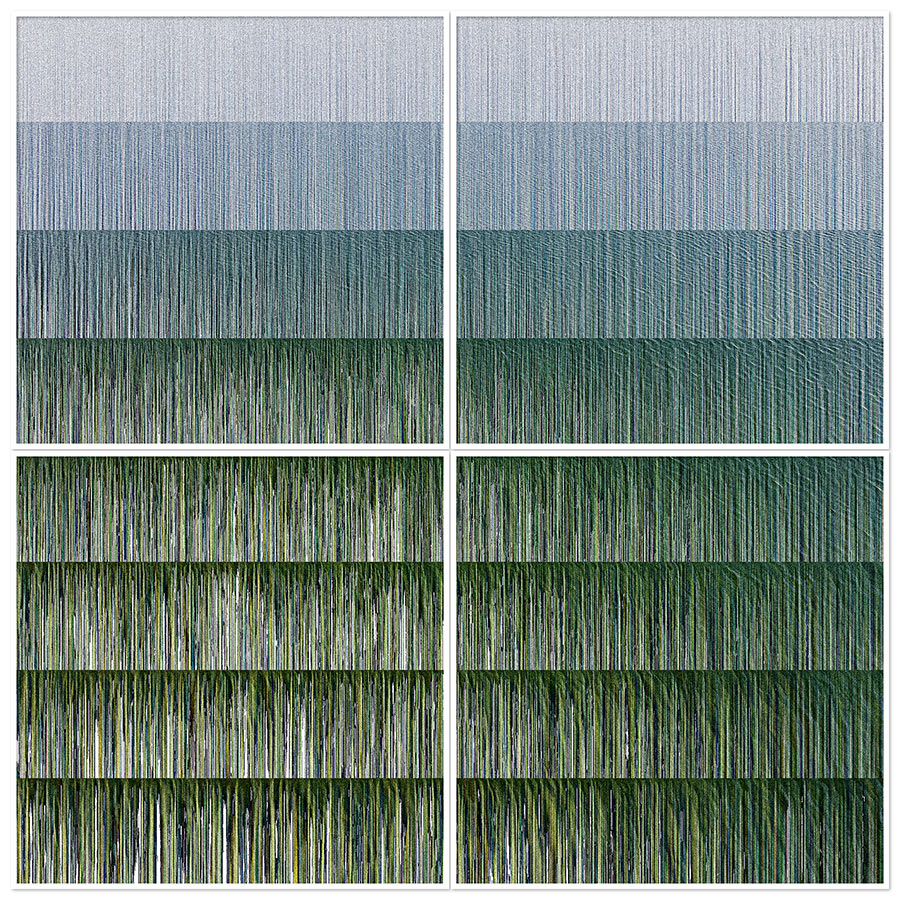
2023-0017 _ 04M2 /
/ 4 teilig – 4-part /
/ je – each 64x64cm – 25,2×25,2inch /
/ edition of 4